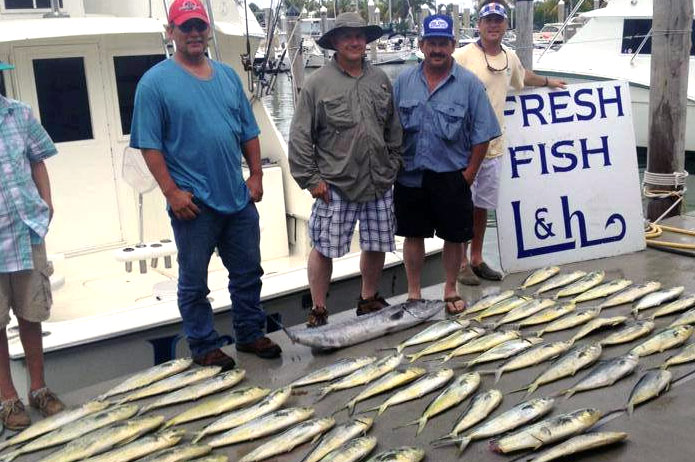Mahi-Mahi Fishing in Florida

Found offshore in temperate, subtropical and tropical waters world-wide, mahi-mahi is one of two members of the Caryphaenidae family; the other being the pompano. Otherwise known as Dorado, these ray-finned fish live near the water’s surface. In Florida, anglers catch many of these beautiful and spectacular fish. They inhabit the waters of the Caribbean Sea, the west coast of North and South America, the Pacific coast of the Gulf of Mexico and Costa Rica, the Atlantic coast of Florida, Hawaii, Southeast Asia and the entire equatorial region.
These magnificent fish are also referred to as “dolphins”. This causes people to confuse them with the widely-known marine animals of the same name. They are not related in any way; their species is the Dorado dolphinfish, while the pompano dolphinfish also falls into this category and they bear no similarities. The word mahi-mahi means very strong in Hawaiian, which is exactly what they are.
Mahi-mahi has very long dorsal fins that extend the length of their compressed bodies. Their caudal fins and anal fins are sharply concave and they are easily identified by their bright colors; which consist of stunning bright greens and blues on their back and sides, as well as gold on their sides. They have blunt-shaped heads and males have noticeably prominent foreheads that sit high and protrude well above the body. The head of the female is rounded and they are smaller than males. These fish experience fast growth and short life spans, averaging about five years of age. Generally they are caught between 15lbs and 30lbs in weight, but can weigh as much as 90lbs.
These fantastic fish are known to change color when out of the water. They will go through several hues before fading to a faint yellow-grey at death. Mahi-mahi feed on crabs, squid, mackerel and various forage fish; but their main diet consists of flying fish. They spawn throughout the year and their young inhabit seaweed. These fish find protection near reef edges in about 120ft of water; hiding among Sargassum weeds, floating wood such as palm trees and fronds, fish buoys and other floating debris - and this is where anglers will find them. Known to reach speeds nearing fifty knots, they are amazingly fast swimmers.
It is known that frigate birds act as sentinels for anglers targeting mahi-mahi. This is because these fish do not venture far from the Sargasso weed lines. Sargassum is floating seaweed that houses complete ecosystems from tiny organisms to medium-sized bait fish. Birds dive for food living in the Sargasso, alerting anglers as to their location. Experienced fishing guides can even tell which species are active there by watching the behavior of these birds.
In the sport fishing world, mahi-mahi are incredibly sought-after. Not only are they immensely delicious, they are phenomenally beautiful and will leap and jump in an incredible acrobatic display. Preferring the company of others, they are found swimming in schools. It is fairly common to have three or four mahi-mahi on your lines at one time, majestically leaping about. They can grow very large and have healthy, abundant populations. Here is some information to help you catch mahi-mahi in Florida:
Tackle for Mahi-Mahi
A conventional medium-weight setup is more than adequate. Keep your tackle light in order to feel the incredible fight these fish offer. A quality saltwater bait-casting rod and reel will work perfectly. 30lb test line with circle hooks is recommended.
Bait for Mahi-Mahi
Live ballyhoo is the most popular bait for these fish. They can be caught on squid, shrimps or any traditional bait fish such as sardines or mackerel. Cut bait works well, as do lures and flies.
Techniques for Mahi-Mahi
We mainly troll for mahi-mahi using live bait. Teasing them is highly recommended and there are a number of ways to do this; from dredges, kites, chum, hookless lures and a net full of live sardines. Bait-and-switch methods are popular too. The goal is to get these hungry fish excited and into a feeding frenzy. Here are some tips on how to catch mahi-mahi in Florida:
- If you are fly fishing, then making use of teasers is essential. Bait-and-switch techniques are ideal. Find the birds mentioned above to locate big fish and toss live chum into the water. You can also use a hookless lure for the same effect. When the fish are feeding, you can cast a fly into the frenzy.
- You can troll lures with rubber skirts or plugs such Rapalas. In fact, a wide variety of lures will work in an area concentrated with many mahi-mahis. Poppers are a great deal of fun to use as well. Remember, if you take the time to use teasers and work them into a hungry ball of fish; they will eat whatever you cast to them. Be aware when using heavier lures and avoid them if you can. These fish jump wildly when hooked and you may find heavy lures flying back at you with incredible speed.
- Troll live baits using a kite. This is a great teaser because the kite keeps the bait near the surface of the water. This makes it appear as if the fish is panicking which is simply irresistible to a mahi-mahi.
- You can troll cut or live bait behind the boat. If you use a good chum then these fish will eat practically anything, whether it is alive or dead.
Call now to book your Mahi-Mahi Fishing Charter in Florida and delight in the spectacular display of beauty.


Comments (0)